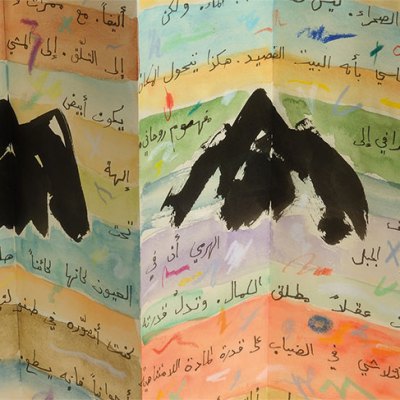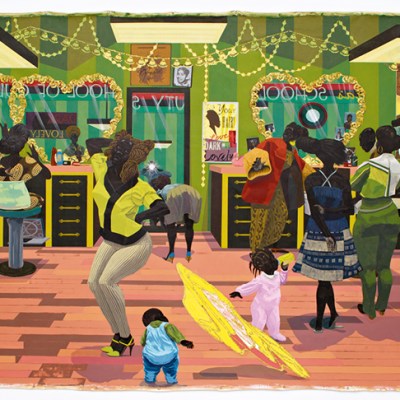Betye Saar greets me, complaining. ‘I woke up in pain, so I’m grumpy today,’ says the artist, who will turn 93 a few days after we meet in late July. Recently she’s had to do so many ‘silly interviews’, she says, she has been left with no time to work. I’m not offended – it’s an understandable grievance. This year, when she might have hoped to enjoy some quiet time in her studio, or to tend her splendid hillside garden in Laurel Canyon, Los Angeles, she has instead been obliged to prepare for major solo exhibitions at the Los Angeles County Museum of Art (until 5 April 2020) and at MoMA in New York (until 4 January 2020). On 2 November she will be honoured at LACMA’s annual Art+Film Gala, a calendar highlight for Los Angeles’ cultured elite.
‘People keep saying, “Oh, so many things are happening for you,”’ she says, ‘but I’m so really tired of it already!’ It’s a problem that many senior artists have had to contend with in recent years, especially female artists and artists of colour. In its rush to ‘rediscover’ figures who may have been overlooked earlier in their careers, the art world can put unfair pressure on folk who might otherwise have been looking forward to taking it easy late in life. In addition, the degree to which these artists are being rescued from poverty or anonymity is often condescendingly overestimated; Saar, for instance, has led a comfortable middle-class existence for several decades now, and has had solo museum exhibitions throughout her career (including at the Whitney Museum of American Art and the San Francisco Museum of Modern Art in the 1970s). In Spirit Catcher, a television documentary about Saar recently screened at Roberts Projects, Los Angeles, she acknowledges that ‘it seems to a lot of people that my so-called success is coming late’. The programme was made in 1977, when Saar was 51. The museum shows this autumn, she tells me, are ‘just another gig’.
Grumpiness, however, does not suit Saar. Quickly her demeanour softens, and she regains her naturally bright spirit and her quick, wry sense of humour. When I ask her what will be in the MoMA show, timed to inaugurate the museum’s renovated galleries, she smiles and sings teasingly, ‘It’s gonna be quite different! It’s gonna open some eyeballs!’ The exhibition draws on the museum’s holdings of Saar’s early prints and her canonical assemblage sculpture Black Girl’s Window (1969); she finally hints that it is her use of colour in the installation of these works that will reinvigorate MoMA’s usually ‘rather staid’ galleries.
Black Girl’s Window (1969), Betye Saar. Photo: Rob Gerhardt/The Museum of Modern Art, New York; courtesy the artist and Roberts Projects, Los Angeles; © Betye Saar 2019

Saar is eager to show me the new sculptures she is working on in her studio – a converted garage, for which she has no use now that she no longer drives. There is another studio upstairs, also filled with work, connected to the lower level by a stairlift. She gestures towards a table bearing a wicker chair piled with dolls and strips of fabric, as well as an arrangement of found objects on a miniature child’s piano. ‘This piece and this piece have been out here since 2017, and I haven’t had a chance to work on them. That’s one of the things I’m grumpy about!’ The dolls, their faces stitched from black fabric with exaggerated pink round mouths, are from Saar’s extensive collection of racist bric-a-brac, most of which she acquires from antique shops or flea markets.
Today, even the mention – let alone the actual appearance – of derogatory black caricatures is unfailingly shocking. But that was not always the case, for non-black viewers at least. In 1972, Saar created one of her most famous sculptural assemblages, The Liberation of Aunt Jemima, which was based on a figurine designed to hold a notepad and pencil. Aunt Jemima was originally a character from minstrel shows, and was adopted as the emblem of a brand of pancake mix first sold in the United States in the late 19th century. The character, an incarnation of the ‘mammy’ stereotype, represented domestic servitude and a comforting familial presence, rooted in the history of enslaved black women working as maids and nannies. (Lest this all sound like distant history, note that Aunt Jemima pancake products are still sold in US supermarkets, the brand owned by Quaker Oats, which is in turn a subsidiary of PepsiCo.)
The Liberation of Aunt Jemima (1972), Betye Saar. Photo: Benjamin Blackwell; courtesy the artist and Roberts Projects, Los Angeles; © Betye Saar 2019

When, in the early 1970s, Saar saw an open call to submit artworks for an exhibition themed around black heroes at a community centre in Berkeley – then the home turf of the Black Panthers – she responded by transforming the Aunt Jemima figurine into a fearsome heroine. Four years after the assassination of Martin Luther King and seven years after the Watts riots, Saar was flushed with anger and frustration at the sputtering progress of the Civil Rights Movement. Instead of a pencil, she inserted a toy rifle, tucking a pistol beneath Aunt Jemima’s other arm. Where the notepad was once attached, Saar added a vintage postcard of a smiling mammy figure clutching a wailing mulatto baby, a vulgar joke about the common sexual exploitation of black slaves or servants by their white masters. Finally, front and centre, she affixed the clenched fist of the Black Power salute.
It is worth noting that Saar has never been an activist, still less a paid-up member of the Black Panthers. By the early ’70s, Saar’s two older daughters (Lezley and Alison, both artists) were graduating and setting off for college, and the youngest, Tracye, was entering her teens. Betye, who had maintained her printmaking practice in what little spare time she could glean for herself, finally found the freedom and opportunity to broaden both her artistic and political thinking. The Liberation of Aunt Jemima, which hotwired a familiar emblem of American domesticity with radical militant politics, encapsulates the double consciousness of Saar’s life and work from this time.
As it happens, Saar has always moved between vastly different worlds and contexts. Her mother was mixed race, but mainly white Irish; her father, who died when she was five years old, was black, hailing from Lake Charles, Louisiana. They met as students at UCLA; Betye was their first child, born in 1926. After the death of her father, the family moved in with Betye’s paternal grandmother, who lived in Watts, then a semi-rural area of south Los Angeles where an eccentric Italian named Simon Rodia was building ornate towers in his back garden from rebar and concrete, crusted in coloured glass and tile. A year later, the family relocated to the city of Pasadena, but Saar remembers returning to Watts regularly, and gazing with wonder at Rodia’s Watts Towers as she walked with her grandmother along the railway tracks to the market.
In Pasadena, Saar attended both the Christian Science Church (which was mainly white) with her mother, and the Episcopalian Church (which was mainly black) with her aunt. She was even more affected by her interest in – and experience of – the paranormal. Before the death of her father, Saar says she was clairvoyant: a gift she refers to as ‘mother wit’. As she grew older, the gift faded, although she continues to place great faith in her intuition, and her sense of the magical power inherent in all inanimate things. ‘My belief is in a holistic planet,’ she says. ‘Maybe even the galaxy is holistic. A friend gave me some little beads made from a meteorite that had fallen from the sky. And every time I hold these beads, I say, “These are stars!”’
Throughout her life she has studied diverse branches of mysticism and the occult – subjects with a long tradition in California, and especially prevalent in the 1960s. Saar moved with her husband, the ceramicist Richard Saar (1924–2004), and their first daughter to Laurel Canyon in 1962; by the end of the decade it was the heart of the Californian hippy movement, home to musicians including Frank Zappa (who lived in a log cabin just down the street from the Saars), Neil Young, Joni Mitchell, Jim Morrison and countless other icons of the counterculture.
Her breakthrough sculpture, Black Girl’s Window, incorporates Saar’s own printed motifs from the tarot, as well as from phrenology, astrology, heraldry and palmistry; beneath, a monochrome black silhouette of a female figure holds up her hands (anticipating Kerry James Marshall’s later use of monochrome black in representing African-American skin). Saar has acknowledged the piece as a self-portrait of sorts, a personal cosmology that places the figure of death – a white skeleton on a black ground – at the centre. It was also a direct response to fellow Angeleno David Hammons’ work from a year earlier, Black Boy’s Window (1968), which similarly combined a found window frame and a contact-printed image – in Hammons’ case, a direct impression from the artist’s body. The dialogue between these two pieces signals Saar’s growing involvement with the Black Arts Movement, with which Hammons was already associated, as well as with feminist art.
Nine Mojo Secrets (1971), Betye Saar. Courtesy the artist and Roberts Projects, Los Angeles; © Betye Saar 2019

In 1970, Saar received funding to travel with Hammons to the National Conference of Artists in Chicago, where the two artists visited the Field Museum and viewed the collections of African and Oceanic anthropological artefacts. The experience, for Saar, was revelatory. Recycled materials, including bone, hair, shell, wood and animal skin, were reconstituted as enduringly sacred or magical talismans. While all objects, according to many traditional belief systems, contain varying degrees of inherent power, their precise spiritual meaning arises from how they are combined. Saar began to consider more and more the inner lives of her ancestors, who led rich and free lives in Africa before being enslaved and brought across the Atlantic. She was also drawn to the spiritual practices of slaves once they arrived in America, broadly categorised as hoodoo, and created assemblages such as Mojo Bag (1970), Nine Mojo Secrets (1971) and Ten Mojo Secrets (1972) that were directly inspired by hoodoo ritual objects. The following decade, while artist in residence at the Massachusetts Institute of Technology (MIT), Saar made one of her largest installations, Mojotech (1987), which mixed circuit boards and animal bones, batteries and candles – futuristic and ancient talismans – in a symmetrical ziggurat of wall-mounted panels, obviously evoking an altar.
In the studio, Saar shows me several unfinished sculptures she is currently working on that combine deer (or possibly elk) antlers with metal candelabras, the horns sprouting like hard pale flames where candles would ordinarily be. She sourced many of the antlers, she tells me, from a bijou garden and gift store on Beverly Boulevard; she enquired where they came from, and ascertained only that the shop gets them from a wholesaler in Texas. She does not seem conflicted about this modern-day transactional reality. I ask if she feels there is special power in these objects, and she responds, unhesitatingly. ‘Yes – anything that has to do with a life has power to it.’ She points to another sculpture that contains vertebrae from a snake, and one that has a bunch of hair hanging from it.
Saar remains highly attuned to her ‘mother wit’ when finding objects to use in her art. ‘The way I start a piece is that the materials turn me on,’ she says. ‘I find an object and then it hangs around and it hangs around before I get an idea on how to use it.’ Her intuition warns her off using certain substances, however. ‘There are some things that I find that I get a sensation in my hand – I can’t say it’s a spirit or something – but I don’t feel comfortable with it so I don’t buy it, I don’t use it.’ I’m reminded of the story that Hammons, when he was making sculptures in the 1970s using African-American hair collected from the barbershop beneath his Los Angeles studio, felt he was ‘going insane’ and had to stop using it. ‘You’ve got tons of people’s spirits in your hands when you work with that stuff,’ he explained.
Saar’s two studios are both crammed full with objects waiting to be transformed into art. ‘I have a job for you!’ she tells me. At her command, I bring down from a high shelf a heavy bottle rack (in the style of Marcel Duchamp’s readymade) and a round birdcage, both of which are perched out of her reach, and place them on a table. She stands back to study the effect. ‘I’m trying to use up all the things that I have, before I pass on.’
Taped to a nearby wall is a photocopy from her sketchbook, showing a metal bed covered in glowing blue bottles. It was an idea she first had in 2001; for her exhibition ‘Call and Response’ at LACMA, she has finally realised it using a camp bed that she employed in various previous installations made overseas, because, she says, it folded up small and she was able to carry it with her on the plane. For a 1988 exhibition in Manila, Philippines, she gathered brambles and other branches after a typhoon, and inserted them among the springs. ‘It became really magical and really spiritual – not as with orthodox religion, but with other kinds of religion where nature plays a large part.’
Woke Up This Morning, The Blues Was in My Bed (2019), Betye Saar. Photo: Robert Wedemeyer; courtesy the artist and Roberts Projects, Los Angeles; © Betye Saar 2019

‘Call and Response’ is structured around Saar’s sketchbooks and the sculptures and installations that responded to the ‘call’ of her drawings. The new assemblage, Woke Up This Morning, the Blues Was in My Bed (2019), uses a strip of neon to illuminate the sea of blue bottles from beneath, creating a transcendent visual effect with metaphysical associations. I observe that after years of incendiary, ironic work featuring gut-wrenchingly offensive popular imagery, many of these new pieces seem more abstract or organic in their significance – even optimistic. Their only optimism, responds Saar, is in their beauty – ‘Beauty is important to me’ – and in their recycling of discarded materials. ‘There’s the recycling of energy, the recycling of creativity.’
In case I think Saar is mellowing in her tenth decade, she shows me another half-finished sculpture, provisionally titled Skin Song, which incorporates a reproduction of the infamous cutaway of the 18th-century British slave ship, the Brookes. Hundreds of African slaves are drawn lying side by side on decks, with ceilings so low they could barely sit upright, far less stand. ‘I like this diagram, this pattern, so I use it a lot in my work,’ Saar says, astonishing me that she can be so apparently impervious to the horror it depicts. Of course, she is well aware of its significance. It is a testament to the dignity and profundity of Saar’s vast body of work, however, that ugliness does not preclude beauty, and that as the artist ages and the issues she has so long grappled with show no signs of resolution, she continues to make art that is surprising, and complex, and new.
From the November 2019 issue of Apollo. Preview and subscribe here.
‘Betye Saar: Call and Response’ is at LACMA, Los Angeles, until 5 April 2020; ‘Betye Saar: The Legends of Black Girl’s Window’ is at MoMA, New York, until 4 January 2020.



